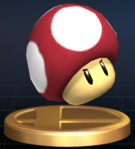Poison Mushroom
| Poison Mushroom | |
|---|---|
 Poison Mushroom artwork from Brawl. | |
| Universe | Mario |
| Appears in | SSBM SSBB SSB4 |
| Item class | Effect |
| Article on Super Mario Wiki | Poison Mushroom |
The Poison Mushroom (毒きのこ, Doku kinoko) is an item that debuted in Super Smash Bros. Melee. It is similar in shape to the Super Mushroom, but has a duller cap and "frowning" eyes. Instead of making the character larger, the Poison Mushroom shrinks any character that touches it. The Poison Mushroom's effect lasts for about 10 seconds. The Poison Mushroom induces the following effects on those who touch it:
- Makes the character smaller, which in turn significantly reduces the size of their hitboxes and hurtboxes.
- Reduces the character's weight by 0.3X, significantly increasing knockback they sustain.
- Reduces the damage and knockback of the character's attacks (more so in Brawl than in Melee).
- Reduces the distance the character can throw items.
- Slightly decreases the character's jumping height.
- Decreases the character's falling speed.
- Slightly decreases the character's walking and dashing speed.
- Reduces the landing lag of the character's aerial attacks.
- Shortens the distance gained by the character's recovery moves in Melee.
- The character's sound effects and voice become higher pitched.
Origin
Poison Mushrooms made their first appearance in the Japanese version of Super Mario Bros. 2 (later released in North America in Super Mario All-Stars as Super Mario Bros.: The Lost Levels). If a player is small and touches a Poison Mushroom, the player loses a life. When the player is big and touches a Poison Mushroom, the player turns back to normal. The Poison Mushroom in Melee and Brawl shrinks whoever touches it. The Poison Mushroom shrinking players could be a reference to how they made Super Mario/Luigi turn back to being Small Mario/Luigi.
Trophies
Melee trophy
Poison Mushrooms made their debut in Super Mario All-Stars, where they'd cost characters a life if picked up. These nasty fungi are dark and foul-tasting, and in Super Smash Bros. Melee, they make you shrink on contact. With your diminished stature comes a loss of power and mass, making you a prime target to get smashed offscreen with even a light attack.
- Super Mario All-Stars (08/93)
Brawl trophy
A penalty item that shrinks whoever grabs it. It's hard to distinguish from a Super Mushroom, so you may find yourself getting small when you wanted to get big. When you're in miniature form, your attack power drops, and even the lightest attack can send you off the stage. That being said, a small target's hard to hit. Your best plan when you're tiny may be to run.
: Super Mario Bros.: The Lost Levels
Trivia
- In Brawl, if Pikachu uses Quick Attack on a falling Poison Mushroom or Super Mushroom, it will perform the size change super jump.
- The Melee trophy states that the Poison Mushroom made its debut in Super Mario All-Stars, but its first appearance actually was in the Japanese version of Super Mario Bros. 2; this error was later corrected in Brawl, using the western title of Super Mario Bros.: The Lost Levels.
- While other items are usually designed to visually stay true to their home series in subsequent Smash titles, the Poison Mushroom is the only item from another series's universe that is deliberately given an original design for the Smash series. Here, it is visually similar to the Super Mushroom instead of the purple hue it is known for in recent Mario games. This is done as an attempt to confuse fighters, similarly to its original Super Mario Bros. 2 appearance (in which it was a different color but not overtly threatening, disguising its deadly nature).
Gallery
| Items in Super Smash Bros. Melee | |
|---|---|
| Normal | Barrel Cannon · Beam Sword · Bob-omb · Bunny Hood · Cloaking Device · Fan · Fire Flower · Flipper · Food · Freezie · Green Shell · Hammer · Heart Container · Home-Run Bat · Lip's Stick · Maxim Tomato · Metal Box · Motion-Sensor Bomb · Mr. Saturn · Parasol · Poison Mushroom · Poké Ball · Ray Gun · Red Shell · Screw Attack · Star Rod · Starman · Super Mushroom · Super Scope · Warp Star |
| Containers | Barrel · Capsule · Crate · Egg · Party Ball |
| Other | Smash Coins |
| Items in Super Smash Bros. Brawl | |
|---|---|
| Normal | Assist Trophy · Banana Peel · Beam Sword · Blast Box · Bob-omb · Bumper · Bunny Hood · Cracker Launcher · Deku Nut · Dragoon · Fan · Fire Flower · Food · Franklin Badge · Freezie · Golden Hammer · Gooey Bomb · Green Shell · Hammer · Heart Container · Home-Run Bat · Hothead · Lightning Bolt · Lip's Stick · Maxim Tomato · Metal Box · Motion-Sensor Bomb · Mr. Saturn · Pitfall · Poison Mushroom · Poké Ball · Ray Gun · Screw Attack · Smart Bomb · Smash Ball · Smoke Ball · Soccer Ball · Spring · Star Rod · Starman · Super Mushroom · Super Scope · Superspicy Curry · Team Healer · Timer · Unira · Warp Star |
| Containers | Barrel · Capsule · Crate · Party Ball · Sandbag · Rolling Crates |
| The Subspace Emissary |
Key · Stock Ball · Trophy Stand |
| Collectibles | CD · Coins · Sticker · Trophy |
| Other | Smash Coins and Bills |




